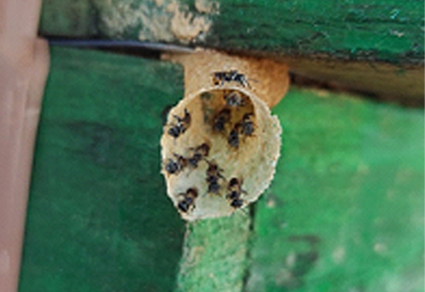Abstract
We describe Lepidotrigona thenzawlensis sp. n., L. rajithae sp. n., L. amruthae sp. n. all from Thenzawl, Mizoram and L. sikkimensis sp. n. from Mamley, Sikkim with associated female and male bees and with a brief note on the nest structure of the former three species. These new species belong to the ventralis species group with body and forewing lengths less than 5 mm in females. These four species are different from the holotype of L. arcifera (from the ventralis group), the only known species from India, in morphometry and ratio of interocellar to ocellocular distance, scape length to eye length, hind tibial length to forewing diagonal length, and hind basitarsus width to hind tibial width are greater than those in L. arcifera. The new species also differ from other species of the ventralis group (L. arcifera, L. flavibasis, L. ventralis, L. satun and L. doipaensis) of the Indo-Malayan region in morphometry, pilosity, structure of male metasomal sterna and male genitalia. Each new species is distinct and can be differentiated from each other based on the structure of male metasomal sterna 4, 5 and 6 as well as genitalia. The brood cells in L. thenzawlensis and L. rajithae were arranged in single-cell thick multi-layered combs. The discovery of these four new species increases the number of species of the genus Lepidotrigona from one to five from India.
References
Attasopa, K., Banziger, H., Disayathanoowat, T. & Packer, L. (2018) A new species of Lepidotrigona (Hymenoptera: Apidae) from Thailand with the description of males of L. flavibasis and L. doipaensis and comments on asymmetrical genitalia in bees. Zootaxa, 4442 (1), 63–82. https://doi.org/10.11646/zootaxa.4442.1.3
Avila, S., Beux, M.R., Ribani, R.H. & Zambiazi, R.C. (2018) Stingless bee honey: quality parameters, bioactive compounds, health-promotion properties and modification detection strategies. Trends in Food Science and Technology, 81, 37–50. https://doi.org/10.1016/j.tifs.2018.09.002
Campos, J.F., dos Santos, U.P., Macorini, L.F.B., de Melo, A.M.M.F., Balestieri, J.B.P., Paredes-Gamero, E.J., Cardoso, C.A.L. & de Picoli Souza, K. (2014) Antimicrobial, antioxidant and cytotoxic activities of propolis from Melipona orbignyi (Hymenoptera, Apidae). Food and Chemical Toxicology, 65, 374–380. https://doi.org/10.1016/j.fct.2014.01.008
Cockerell, T.D.A. (1929) Descriptions and records of bees.—CXX. Annals and Magazine of Natural History, 4, 584–594. https://doi.org/10.1080/00222932908673101
Heard, T.A. (1999) The role of stingless bees in crop pollination. Annual Review of Entomology, 44, 183–206. https://doi.org/10.1146/annurev.ento.44.1.183
Michener, C.D. (2000) The bees of the world. Johns Hopkins University Press, Baltimore, Maryland, 913 pp.
Moure, J.S. (1961) A preliminary supra-specific classification of the old world meliponine bees (Hymenoptera, Apoidea). Studia Entomologica, 4, 181–242.
Quezada-Euán, J.J.G. (2018) Stingless Bees of Mexico: The Biology, Management and Conservation of an Ancient Heritage. Springer, New York, New York, X + 294 pp. https://doi.org/10.1007/978-3-319-77785-6
Rasmussen, C. (2013) Stingless bees (Hymenoptera: Apidae: Meliponini) of the Indian subcontinent: Diversity, taxonomy and current status of knowledge. Zootaxa, 3647 (3), 401–428. https://doi.org/10.11646/zootaxa.3647.3.1
Rasmussen, C., Thomas, J.C. & Engel, M.S. (2017) A new genus of eastern hemisphere stingless bees (Hymenoptera: Apidae) with a key to supraspecific groups of Indomalayan and Australasian Meliponini. American Museum Notitates, 3888, 1–33. https://doi.org/10.1206/3888.1
Roubik, D. W. (1989) Ecology and natural history of tropical bees. Cambridge University Press, New York, New York, 514 pp. https://doi.org/10.1017/CBO9780511574641
Sakagami, S.F. (1975) Stingless bees (excl. Tetragonula) from the continental Southeast Asia in the collection of Bernice P. Bishop Museum, Honolulu (Hymenoptera, Apidae). Journal of the Faculty of Science, Hokkaido University, Series VI, Zoology, 20, 49–76.
Sakagami, S.F. (1978) Tetragonula Stingless Bees of the continental Asia and Sri Lanka (Hymenoptera: Apidae). Journal of the Faculty of Science Hokkaido University Series VI Zoology, 21, 165–247.
Schwarz, H.F. (1939) The Indo-Malayan species of Trigona. Bulletin of the American Museum of Natural History, 76, 83–141.
Umthong, S., Puthong, S. & Chanchao, C (2009) Trigona laeviceps propolis from Thailand: antimicrobial, antiproliferative and cytotoxic activities. American Journal of Chinese Medicine, 37, 855–865.
Viraktamath, S. & Rojeet, T. (2021) Two new species of Tetragonula (Hymenoptera: Apidae: Meliponini) from North-East India with notes on their nest structure. Biologia, 76, 1691–1704. https://doi.org/10.2478/s11756-020-00662-0
Viraktamath, S. & Roy. (2022) Description of five new species of Tetragonula (Hymenoptera: Apidae: Meliponini) from India. Biologia, 77, 1769–1793. https://doi.org/10.1007/s11756-022-01040-8
Viraktamath, S., Tanuja, N. & Nirmala, P. (2020) A technique to collect male stingless bees. Current Science, 119, 435–437.


